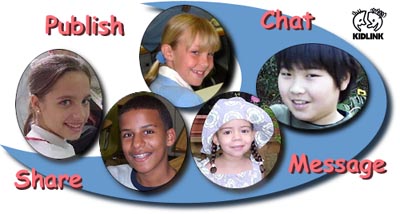Virtual Learning Communities

by: Patti Weeg
What are they?
Virtual learning communities sustain ongoing collaboration among participants who come together because of common interests or goals. These participants may be physically located anywhere in the world. As in any learning community, the online learning community provides services and a support system for those who belong to it. Collaboration over time is a major component of the online learning community. Motivation for all learners is high because there is an audience and a purpose for student project work.
Where are they?
Virtual education communities can be found:
- Kidlink "Empowers kids and youth with free educational programs to help them mature, get better control over their lives, encourage creativity, create social networks, and collaborate with peers around the world, individually or through their classrooms."
- ePals
- a learning community consisting of students, teachers, global partners who share educational activities in within an environment that is safe and secure for youth.
- iEARN - a global network which provides collaborative and educational projects.
- European Schoolnet
- an international partnership of 26 Ministries of Education which develop educational opportunities for youth in Europe and beyond.
- Intercultural E-mail Classroom Connections
- connects students and teachers around the world for project exchanges and dialogue.
- Classroom Connect
- provides online instructional materials and professional development programs for all in K-12.
- Global Schoolhouse
- uses online tools to bring students from all over the world together in learning opportunities.
- Oz Projects
- provides teachers with many resources and excellent online projects that match curriculum goals.
- MiddleWeb
- provides resources for all in education and aims to support high academic achievement for youth in middle school.
Other online communities might include but are not limited to: newsgroups, listservs, bulletin boards, online chats, discussion forums on the Web and blogs.
Things to consider when joining online communities with students:
Before launching out into the deep and joining an online learning community with your students consider the following:
- Does your classroom environment support collaborative work where student use technology?
- Be sure classroom procedure and routines are in place.
- When students are saving files in their project be sure they have good management strategies for their files.
- Before students collaborate with other students online be sure they are familiar with your Acceptable Use Policy. Gather signed permissions from parents or guardians before posting student work, art and text, as well as photos on the Web.
- Prepare students for working in teams.
- Consider how you and your students will evaluate their participation in online collaborative work. See an example from a teacher in Ialy: Project Evaluation by Class 2B - "What Does My First Name Mean?" project
- Special needs students have their place in the virtual learning community. Be sure to made adaptations so that all students can participate.
Kidlink
The success of an online learning community depends on the interaction of all who belong and the quality of the services provided. An example of a virtual learning community that has been in existence since 1990 is Kidlink -
www.kidlink.org
Take a look inside to see what makes Kidlink successful:
- Kidlink's virtual community is born - 1990.
- Participants interact in many ways.
- Kidlink provides lessons and activities for participants.
- Involving families and community
- Benefits and limitations
- Lesson plan for "Kidlink Day" journal project
|
